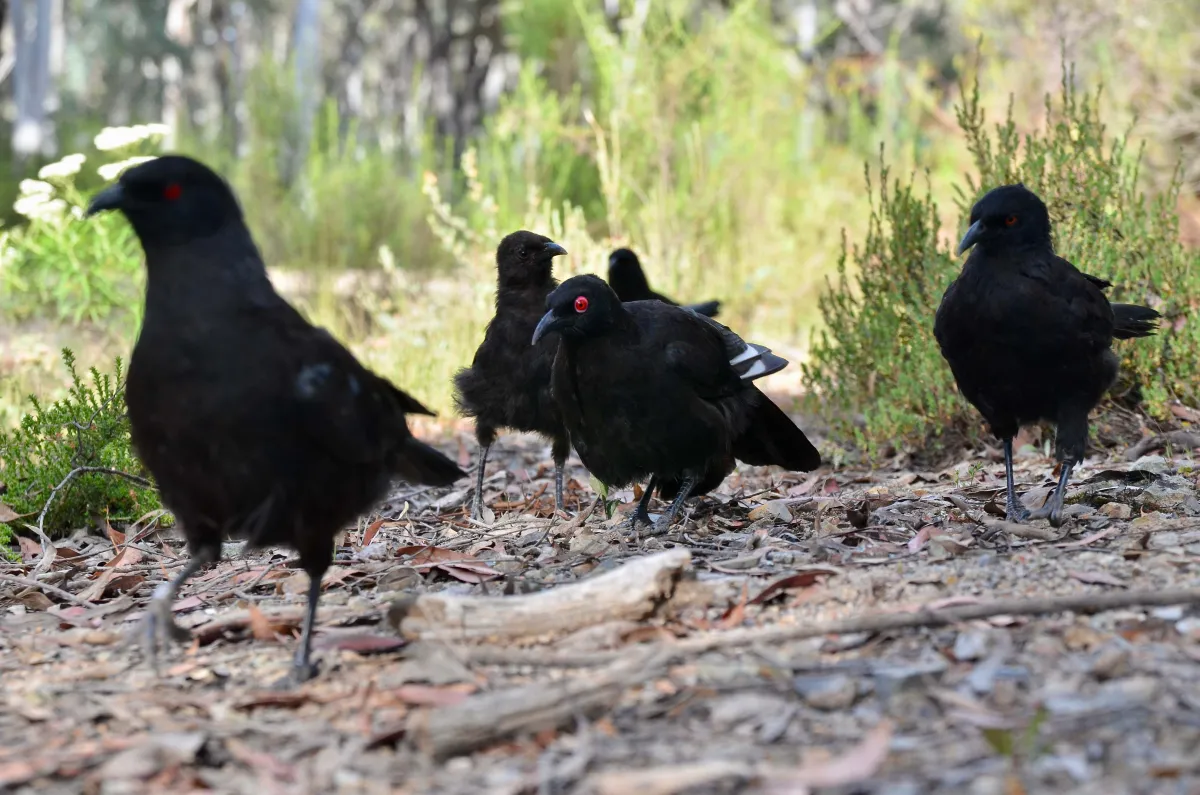Chough love: What’s behind the strange antics of the white-winged chough?

Cover image: Chun-Chieh Liao
They have bulging red eyes, they gather in packs, and engage in gang warfare. And they can be found on most suburban Canberra streets.
The white-winged chough is one of the weirder birds out there.
Even their name, chough, is a bit odd (it’s pronounced ‘chuff’).
And the more you find out about them, the weirder they seem.
Professor Rob Heinsohn from the ANU Fenner School Environment and Society has spent roughly the past four decades researching and observing choughs as they scratch and forage around in leaf letter in Canberra parks and gardens.
He says he finds them “comical and endearing.”
“They're highly, highly social birds. And they're always displaying at each other.”
To display, a chough will open its wings showing off the white feathers, and then often jump about in a kind of jig, all the while being very vocal.
It is, he admits, “bizarre”.
“They fill the conjunctiva around the eye with blood, so it looks like it's bulging out of the head,” Professor Heinsohn describes.
“And then they do the wing flapping and the tail wagging. Sometimes they do this to show dominance, by displaying to subordinates to tell them off, but also during mating time they will display at each other too.”

Choughs are extremely social birds, forming breeding groups of up to 20 birds. Photo: Chun-Chieh Liao
Then there’s the kidnapping.
Professor Heinsohn was the first person to alert the science world to this now infamous behaviour, which he discovered during his PhD research.
As he explains it, choughs are cooperative breeders and need groups of four or more – up to twenty – to raise chicks to adulthood. In their pack, they form alliances and are always looking for ways to help each other.
When the group starts running low on babysitters, that’s when choughs may try to lure over a naïve youngster from another clan by masquerading as family. If they get away with the kidnapping, they adopt the newbie and will have assistance for raising future chicks.
But it’s not just the kidnapping that sets choughs apart.
When the going gets tough, the choughs get going − in an unexpected way.
“The very first PhD student I supervised on choughs was doing their research during one of the severe droughts in the late 1990s,” says Professor Heinsohn. “And we found out that a turf war more or less exploded during hard times.”
There were, he says, “a lot of deaths.”
“It was complete gang warfare, where the choughs were running around, fighting like anything, but also destroying each other’s nests, and trying to kidnap each other's babies in such an elevated way. It was the most fascinating thing.”
But after the drought ended, the choughs reverted to their quirky and loud, but ultimately peaceful selves.

Photo: Chun-Chieh Liao
If you ask current PhD candidate Chun-Chieh Liao about the chough’s most unique feature, he won’t talk about kidnapping. To Liao, it’s all about the chough’s highly complex vocalisations.
He too was immediately enchanted by the choughs’ antics.
“Previously, no one wanted to study their vocal communication because it gets too complicated,” he says.
But Liao was up for the challenge and has been decoding the choughs’ different types of alarm calls for his PhD research with the ANU Research School of Biology.
He’s working with the same chough populations and their descendants as Professor Heinsohn, who is one of his PhD supervisors.
Liao’s recordings show very distinct calls by adult choughs in response to three different alarm call types: terrestrial predators (like snakes or foxes); aerial predators (like raptors); and urgent “flee now” situations.

Liao also discovered that their language is so complicated − and juveniles are so reliant on the family group − that it takes youngsters more than six months to learn to respond properly to these calls.
Such long development times are commonly found in mammals, Liao says. But it’s surprising to find this in birds, who usually learn how to look out for danger in only three weeks.
Compared to being alert to predators, learning foraging skills is probably more important for choughs, Liao says, because they have constant protection from the adults in the group.
However, this is just scratching the surface of chough calls. There are other distinct vocalisations Liao has observed in the field but is yet to formally study. For instance, he’s noted a food call, a travel call, and a “Help, I’m lost” whistle.
For Professor Heinsohn, it’s not despite their strange characteristics, but because of them, that he’s so drawn to choughs.
“They're quintessentially Australian,” he says.
“They’re battlers in the bush, and the way they do group living is all about surviving quite harsh conditions.
“I love that side of them.”
